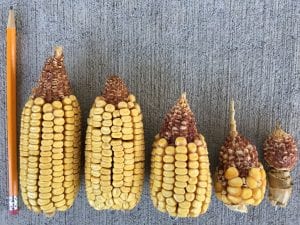Symptoms:
Blunt ear syndrome (BES) is characterized by markedly reduced ear size and kernel numbers per row. Husk length and kernel row number may be normal. However, husks may appear somewhat pointed at maturity, probably because husks are more tightly wrapped around the much smaller ear enclosed. Corn plants with stunted ears generally appear healthy. The problem is sometimes associated with multiple ears at a node or along the stalk below the primary ear. Occurrence of BES is usually limited to small areas within a field (e.g. may only appear in plants growing in head rows or in patches scattered within a field) although there are reports that entire fields have been affected resulting in major yield losses. During late grain fill, husks, leaf midribs, leaf blades, and leaf sheaths of plants with severely stunted ear development become red and purple (anthocyanin pigments).
Cause:
Unknown. Associated with cold temperature shock (and major fluctuations in diurnal temperatures) during ear formation stages (V8-12). These stress conditions may directly injure ear shoot tissue and/or alter the hormonal balance within the developing ear shoot resulting in BES. The severity of symptoms differs among hybrids.
Given the fact that affected plants appear otherwise normal suggests that the cause of BES ear is NOT a lingering or cumulative type of stress (e.g., compaction, drought stress, nutrient deficiency), but rather a single stress event that directly affected the developing ear.
Management:
Avoid planting hybrids susceptible to blunt ear syndrome in fields where the problems has occurred previously. However information on susceptibility among hybrids may be limited. Given that the frequency of BES problems is usually rare and limited to a small percentage of plants within a field, it may not warrant major consideration in hybrid selection.
References:
Ciampitti, I. 2014. Abnormal Corn Ears. Available at https://www.agronomy.k-state.edu/extension/documents/crop-production/Abnormal_Corn_Ears.pdf [URL verified 10/8/2019]. Kansas State University.
Lejeune, P. and G. Bernier. 1996. Effect of environment on the early steps of ear initiation in maize (Zea mays L.) Plant, Cell and Environment. 19:217-224.
Nielsen, R.L. (Bob). 2007. Symptomology of Arrested Ear Development in Corn. Corny News Network, Purdue Univ. [On-Line]. Available at www.agry.purdue.edu/ext/corn/news/articles.07/arrestedears-0904.html. [URL verified 10/8/2019].
Nielsen, R.L. (Bob). 2009. Blunt Ear Syndrome….Again. Corny News Network, Purdue Univ. [On-Line]. Available at http://www.kingcorn.org/news/timeless/BluntEars.html [URL verified 10/8/2019].
Strachan, S.D. 2004. Corn Grain Yield in Relation to Stress During Ear Development. Crop Insights Vol. 14, no. 1. Pioneer Hi-Bred, Johnston, IA. Available at https://www.pioneer.com/us/agronomy/ear_development.html [URL verified 10/8/2019].


